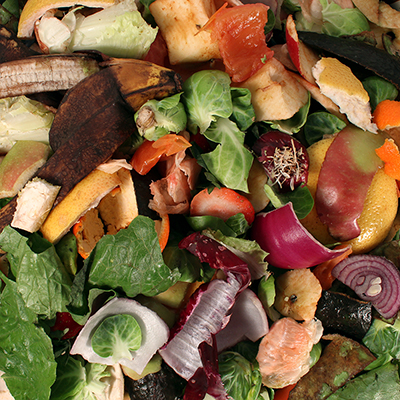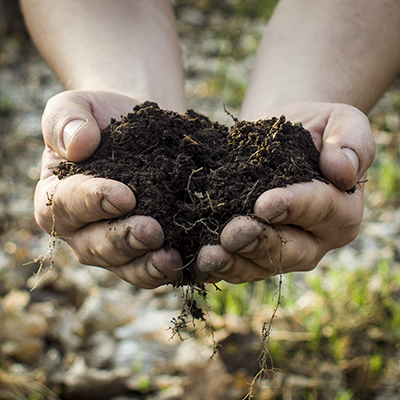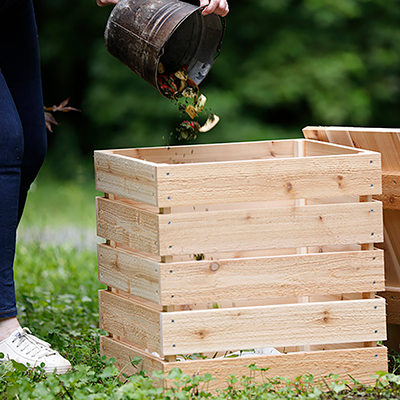Best Compost Bin for Your Home

Last updated October 29, 2024
Compost is created by the breakdown of organic waste such as kitchen scraps, leaves, plants and weeds. The resulting decomposed material
nourishes plants, retains moisture and promotes biological activity in the soil.
You can generate quality organic compost soil quickly and easily at home. Read this guide to understand the basics of organic composting and the types of composters available so you can pick the one that works best.
Table of Contents
How Does Composting Work?
Stages of Composting
Stationary Bins
Compost Tumblers
Worm Bins
Composting Blenders and Food Recyclers
How Does Composting Work?

Composting is a complex process that breaks down kitchen scraps and plant debris into organic material that benefits your garden.
Bacteria make up 80 percent to 90 percent of the microorganisms that break down organic matter in your compost bin. Microorganisms devour the plant material on a cellular level, creating water and carbon dioxide and generating heat. A healthy outdoor compost pile will heat up to about 140 degrees Fahrenheit at its core as the microorganisms do their work.
You can create effective "cold" compost piles that break down plant material, just more slowly. Cold compost is made by piling waste materials and letting them break down for a year or two with an occasional turn, if possible. Cold compost piles are susceptible to weed and seedling growth that could impede some of the organic composting process. Cold compost is typically created in piles or heaps placed out in the open with no containers.
Hot compost comes from a compost pile constructed with a balance of nitrogen-rich and carbon-rich materials that are turned regularly, at least once every week or two. It is also kept evenly moist with occasional watering. Hot compost becomes very hot to the touch due to the organic breakdowns constantly occurring, killing weed seeds and many disease pathogens.
Stages of Composting

When the materials are first heaped together in a compost bin or pile, they begin the mesophilic stage. During this time, the core temperature rises and microorganisms form colonies and multiply within the pile. The mesophilic stage lasts for less than a week, and during this time you should see your compost "sag," or settle.
The second stage is the thermophilic phase; in this stage the compost temperatures get up to 140 degrees Fahrenheit. When organic materials reach that temperature, seeds from weeds are killed, harmful bacteria die off and the pile starts to break down rapidly. The thermophilic phase can be assisted by making sure your compost pile is damp. A popular rule of thumb is that it should be as wet as a wrung-out sponge. There should be sufficient air reaching the core of the pile.
Turning the pile once or twice during this stage gets oxygen to the center, and watering the compost pile keeps the heat in. This stage can last up to three months depending on how much attention you pay to the heap, what you are trying to compost and what sort of bin or pile you are using.
The final stage of composting is known as the cooling stage. This is where the compost settles into a uniform mix. This can take up to four months. Turning occasionally is important. During this final stage, you may want to begin a second compost location and refrain from adding to the near-complete one.
Your compost is ready to use when it is a rich brown color, earthy smelling, free of large pieces of debris and has a crumbly consistency.
Stationary Bins

Stationary compost bins are boxes with air slits on the side. The bin allows for higher heaps that can increase heat at the core necessary for food scraps and other organic waste to convert into compost. Stationary compost bins can be used indoors or outdoors.
Tip: Set up two bins next to each other so you always have one bin actively decomposing and the other with new material. Transfer decaying material from the new to the old. Some gardeners use a three-bin system that moves finished compost to the last bin where it can age.
Compost Tumblers

Tumblers are built to process compost from kitchen and yard waste in less time. The tumbler is rotated with a crank or rolled on the ground. The sealed container retains the heat generated by the materials, which speeds up the composting process. Most compost tumblers are compact in size and suitable for limited yard space. They are most effective when all material is added at once instead of gradually.
Worm Bins

Earthworms in the worm bins are good at breaking down the organic household waste that becomes compost. The worm castings they leave behind after digesting the waste are rich in nutrients. Harvest the dark-colored castings from the compost bins every three to six months and mix them into garden soil as fertilizer.
Tip: Add finished vermicompost (worm castings) to your garden beds to reduce pest and disease pressure. If you don't have a worm bed, you can purchase vermicompost with soil amendments in the Garden Center.
Composting Blenders and Food Recyclers

There are new appliances that aid in managing food waste. These products are often called food recyclers and they heat, blend and dry organic food waste to create a soil amendment that will benefit your garden. While not technically compost, the end product can be used in a similar fashion in your garden.
Compost recyclers work similarly to compost bins. You fill your food recycler with kitchen scraps like vegetable peels, coffee grounds and egg shells. If you plan to use the end product in your garden, keep in mind to never put oils, fats or meat products in a composter.
Tip: Using a food recycler reduces trash volume by up to 90 percent. If you don't have a garden, you can throw out the end product and still have the benefit of reducing your trash volume.
Indoor Compost Bins

An indoor compost bin is the best compost bin for your home if you have a small space. You can store the bin in any dark and dry space, such as a basement or the cabinet underneath the kitchen sink. An indoor compost bin works year-round to break down plant scraps.
Rodent-Resistant Compost Bins

Compost heaps are certain to attract small rodents like rats and mice looking for an easy meal. Choose a compost bin that makes it hard for rodents and other scavengers to get to composting kitchen scraps.
Wood Composter

The easiest way to create organic garden compost is to simply pile up your organic materials in heaps and let them break down. In your yard, set up a composter system made of weather-resistant cedar. Compost bins from wood are among the most economical of options.
Wire Compost Containers

A compost bin of heavy-duty coated wire is another alternative to an enclosed composter. Most wire compost bins are weather resistant and designed to keep small animals out. Choose multiple wire bins to separate the organic waste and compost piles in different stages of decomposition.
Dual-Chamber Bins

A dual-chamber compost bin allows you to create twice the amount of compost. Add kitchen scraps and yard waste to one side of the bin as the previously added compost batch continues to cure on the other side.
Choose a compost bin that converts organic plant material into nutrient-rich compost that helps your garden thrive and grow. When you are ready to choose the best compost bin for your home, download The Home Depot Mobile App and search for the items you want to buy.


































